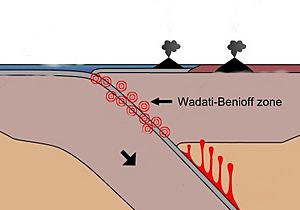Wadati–Benioff zone facts for kids
A Wadati-Benioff zone is a special area deep inside the Earth where many earthquakes happen. These earthquakes occur because huge pieces of the Earth's outer layer, called tectonic plates, are slowly moving and crashing into each other. When they meet, one plate often slides underneath the other.
Imagine two giant puzzle pieces of the Earth's surface moving towards each other. When they collide, one piece (the downgoing plate, usually from the ocean floor) dives beneath the other piece (the overriding plate). As the downgoing plate sinks deeper into the Earth, it causes earthquakes. Shallow earthquakes happen where the plates first meet, and deeper earthquakes happen as the plate continues to sink. These deep earthquakes form the Wadati-Benioff zone. Some of the deepest earthquakes ever recorded, reaching up to 650 kilometers (400 miles) deep, come from these zones!
Who Discovered Wadati-Benioff Zones?
In 1935, a Japanese scientist named Kiyoo Wadati published his research about deep earthquakes. He noticed that these deep quakes often happened near the edges of continents. Later, in 1945, an American scientist named Hugo Benioff studied earthquakes even more. He found a way to figure out exactly where an earthquake started. The slanting area of earthquake activity that they both helped discover was named in their honor: the Wadati-Benioff zone.
Learn More About Earthquakes
- USGS Glossary: Benioff Zone
- Penn State: Wadati-Benioff Zones
Images for kids
-
Diagram of a Wadati–Benioff zone, from the United States Geological Survey
-
Earthquake activity in the Kuril Islands subduction zone, showing the 2006 earthquake marked with a star.
See also
 In Spanish: Zona de Wadati-Benioff para niños
In Spanish: Zona de Wadati-Benioff para niños




